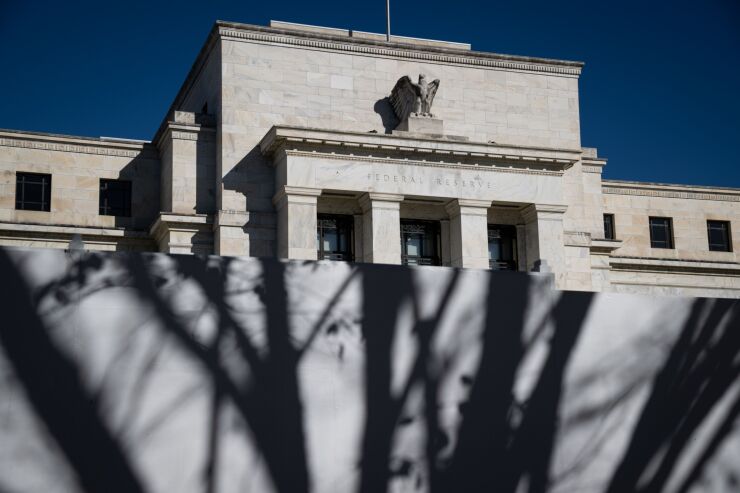
Though it won't happen overnight, the Federal Reserve's FedNow instant-payments rail set to go live late this month is likely to displace certain types of credit and debit card transactions, according to a cross-section of payments industry experts.
Any shift away from card payments will be very gradual, because FedNow's rollout is taking place in stages for most providers. The first wave of bank users has just
One factor that could accelerate adoption of FedNow — and its potential to displace existing payment methods — is economic volatility, according to analysts.
"A tool that can immediately move funds from one organization or individual to another in real time, at a very low cost, should inevitably impact card usage going forward. It won't replace cards or other payment alternatives, but it will surely have an impact," said Thad Peterson, a strategic advisor with Datos Insights.
Instant-payment rails have already absorbed many new payment flows, with millions of businesses recently adopting The Clearing House's six-year-old
FedNow's use cases and transaction modes are still evolving, Peterson said. But the economic forces driving lower-cost, faster payment cycles are destined to be a tailwind for these various faster-payment rails.
The major
But the near-term potential for FedNow to displace many legacy business-to-business payment flows between trusted parties could be a negative for some banks, Moody's recently warned.
"While FedNow will help small banks improve payment competitiveness, it also could be a credit negative for banks as it will reduce revenue from payment fees and float and may exacerbate deposit-funding risks," said Stephen Tu, vice president and senior credit officer at Moody's, in a recent report to investors.
FedNow is likely to reduce the revenues of payments firms and banks that rely heavily on debit and credit card interchange fees, he warned.
"Small-business owners may be among the greatest beneficiaries of FedNow as they can face payment delays of several days for funds settlement and costly handling charges, especially on credit cards," Tu said.
It's impossible now to predict what percentage of transactions FedNow may absorb from cards, checks, ACH or wire transfers, said Meghan Oakes, vice president and head of enterprise payments at Jacksonville, Florida-based bank technology core provider FIS.
"I do think that FedNow is going to take a bite into all payment types in some way, shape or form," Oakes said.
FIS has signed up about 20 institutions — large, small and midsize — that will go live with FedNow this month, out of FIS' hundreds of financial institution customers, she said. Participating institutions' customers initially will be able to receive FedNow payments only; during the second half of this year, FIS will work on enabling the ability for them to send payments, and follow it with the ability for participants to request payments.
"Especially in business-to-business transactions, getting funds instantly is a game changer because it provides businesses with access to cash when they urgently need liquidity," Oakes said.
Fintechs and third-party payment providers have mixed views on the potential effect of FedNow on credit and debit card volume.
"As consumers and businesses shift to real-time payments, it may cause some card payment volumes to decline," said Hal Ramakers, senior vice president at
But even the smallest financial institutions now have the opportunity to more effectively serve consumer and corporate customers by artfully blending real-time payment products available from FedNow, The Clearing House, card networks and P2P networks, Ramakers suggested.
"FedNow will enable existing banks and card issuers to offset potential losses from card interchange by reclaiming previously lost revenue on products and services that fintechs captured by offering private money transfer and remittance services at lower costs," Ramakers said.
As an expert in the field of helping merchants navigate credit card disputes, Rodrigo Figueroa, chief operating officer at Chargeback Gurus, is skeptical about whether consumer credit and debit card usage will take a hit in the foreseeable future from FedNow.
"People are talking about FedNow like it will be this massive disruptor in the marketplace, but I don't see it," Figueroa said. "Card industry forces will work to protect their market share, and the cost of moving toward an entirely new standard for sending consumer payments — where there's no established track record for managing disputes — will be huge. Who wants to make an investment in something where you're potentially undermining existing revenue streams and taking new risks?"
Robert Hammer, CEO of Los Angeles-based payment industry consulting firm R.K. Hammer, also doesn't expect much immediate impact from FedNow on today's credit and debit card transaction volumes, due to cards' deep entrenchment in consumer and commercial business models.
"FedNow has a long way to go to get all major financial institutions certified and on board," Hammer said, noting that much depends on how many banks prioritize integration of FedNow in the next several months.
But if FedNow achieves a high participation rate in its first year among the estimated 10,000 U.S. financial institutions eligible to support it, card networks might see volume declines sooner, he said.
"Let's see what the penetration level of FedNow is for major bank participants in a year. Until then, the death of cards and related payments seems farfetched," Hammer said.






